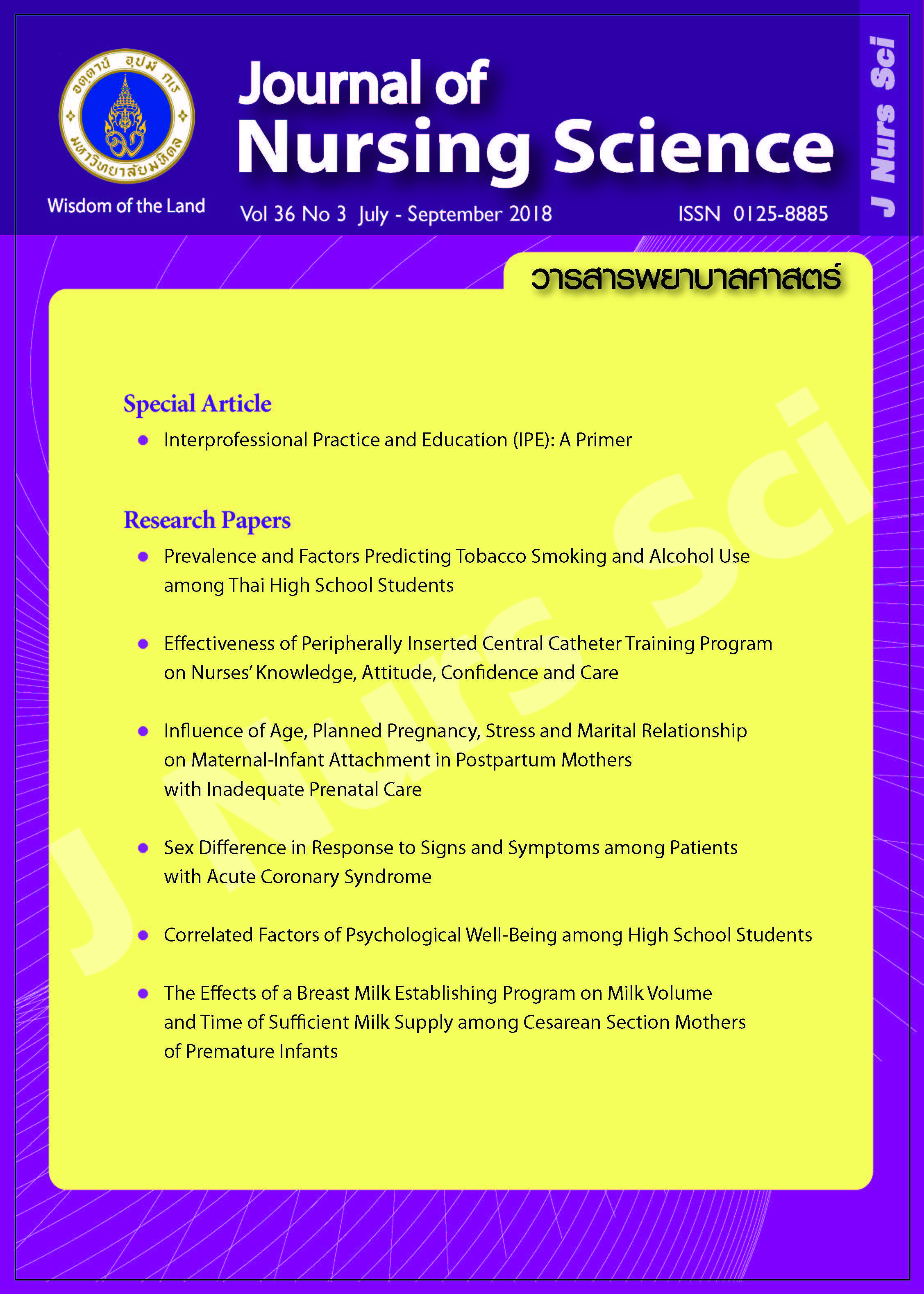The Effects of a Breast Milk Establishing Program on Milk Volume and Time of Sufficient Milk Supply among Cesarean Section Mothers of Premature Infants
Main Article Content
Abstract
Purpose: To evaluate the effects of a breast milk establishing program on breast milk volume and time of sufficient milk supply among cesarean section mothers of premature infants.
Design: Quasi-experimental design.
Methods: Twenty-eight participants were recruited by convenience sampling, with 15 participants in the control group and 13 participants in the experimental group. The experimental group received the lactation stimulation program consisting of giving information related to the infants, providing knowledge regarding the mechanism of milk synthesis, hot compress, breast massaging and breast milk expressing. Breast milk volume on Day 4 and Day 10 and the time to have sufficient milk were compared between groups using a t-test.
Main findings: There were no statistical different in breast milk volume of the mothers in the experiment and the control groups at Day 4 (70.39 ± 57.29 VS 79.52 ± 84.10, p = .36) and Day 10 (360.76 ± 191.00 VS 266.06 ± 191.15, p = .101). The time to have sufficient milk was also not different between the study groups (5.6 ± 1.6 VS 5.3 ± 1.8, p = .296).
Conclusion and recommendations: Although the results did not reveal a significant difference between groups, benefits of the establishing the breast milk program could help mothers with premature cesarean section to produce and maintain breast milk for their infants. Nurses should adjust this program and monitor the mothers for the regularity and continuity of their breast milk expression.
Article Details
Copyright Notice: Nursing Science Journal of Thailand has exclusive rights to publish and distribute the manuscript and all contents therein. Without the journal’s permission, the dissemination of the manuscript in another journal or online, and the reproduction of the manuscript for non-educational purpose are prohibited.

Disclaimer: The opinion expressed and figures provided in this journal, NSJT, are the sole responsibility of the authors. The editorial board bears no responsibility in this regard.
References
2. Dewey KG. Maternal and fetal stress are associated with impaired lactogenesis in humans. J Nutr. 2001;131(11):3012-5.
3. Pinchaleaw D, Serisathien Y. Women’s distress after cesarean section. Journal of Nursing Science. 2009;27(2):18-38. (in Thai).
4. Ng K, Parsons J, Cyna AM, Middleton P. Spinal versus epidural anesthesia for cesarean section. Cochrance Database Syst Rev, 2004;(2):CD003765. doi: 10.1002/14651858.CD003765.pub2. PubMed PMID: 15106218.
5. Neville MC, Morton J. Physiology and endocrine changes underlying human lactogenesis II. J Nutr. 2001;131(11):3005S-8S.
6. Lawrence RA, Lawrence RM. Breastfeeding: a guide for the medical profession. 7th ed. Maryland Heights, Missouri: Elsevier Mosby; 2011.
7. Charoenrungdet K, Anuchitchanchai J, Promchot N, Suntornwisas A. The effectiveness of breast massage and breast compression with baby diapers moistened with warm water to stimulate maternal lactation after childbirth during the first 72 hours. Uttaradit Hospital Medical Bulletin. 2013:28(3):24-36. (in Thai).
8. Jones E, Dimmock PW, Spencer SA. A randomized controlled trial to compare methods of milk expression after preterm delivery. Arch Dis Child Fetal Neonatal Ed. 2001;85(2):F91-5.
9. Kangkan T, Sangperm P, Wichiencharoen K. Effect of nipple stimulation program on mothers’ breast – milk volume of preterm infants. Kuakarun Journal of Nursing. 2014;21 Suppl:205-18. (in Thai).
10. Kaewnil W, Jintrawet U, Urharmnuay M. Effects of coaching on maintaining breast milk among mothers of preterm infants. Nursing Journal. 2013;40(3):11-20. (in Thai).
11. Cohen J. Statistical power analysis for the behavioral sciences. 2nd ed. Mahwah, NJ:
Lawrence Erlbaum Associates; 1988.
12. Wongsiri A. The effect of massage to increase breast milk. In: Wijitsukol K, Sangperm P, editors. Continuing nursing education: breastfeeding. Bangkok: Siriyod; 2014. p.45-53. (in Thai).
13. Penn Z, Ghaem-Maghami S. Indications for caesarean section. Best Pract Res Clin Obstet Gynaecol. 2001;15(1):1-15.
14. Smith JM, Lowe RF, Fullerton J, Currie SM, Harris L, Felker-Kantor E. An integrative review of the side effects related to the use of magnesium sulfate for pre-eclampsia and eclampsia management. BMC Pregnancy Childbirth. 2013;13:34.
15. Gadsden J, Hart S, Santos AC. Post-cesarean delivery analgesia. Anesth Analg. 2005;101(5 Suppl):S62-9.
16. Kutlucan L, Seker IS, Demiraran Y, Ersoy O, Karagoz I, Sezen G, et al. Effects of different anesthesia protocols on lactation in the postpartum period. J Turk Ger Gynecol Assoc. 2014;15(4):233-8.
17. Wormald F, Tapia JL, Torres G, Canepa P, Gonzalez MA, Rodriguez D, et al. Stress in
parents of very low birth weight preterm infants hospitalized in neonatal intensive care units. A multicenter study. Arch Argent Pediatr. 2015;113(4):303-9.
18. Dimitraki M, Tsikouras P, Manav B, Gioka T, Koutlaki N, Zervoudis S, et al. Evaluation of the effect of natural and emotional stress of labor on lactation and breastfeeding. Arch Gynecol Obstet. 2016; 293(2):317-28.
19. Brownell E, Howard CR, Lawrence RA, Dozier AM. Delayed onset lactogenesis II predicts the cessation of any or exclusive breastfeeding. J Pediatr. 2012;161(4):608-14.
20. Embleton ND. Optimal protein and energy intakes in preterm infants. Early Hum Dev. 2007;83(12):831-7.

